Reel Fishing: Master’s Challenge – Review
by Mark R
|
 A lot can be said for fishing games, even though they’re undoubtedly overlooked by the mass market. There’s not a great deal of brain power required, there’s generally a somewhat serene approach to the delivery, and it’s typically some time before any frantic gameplay is required and so, from that perspective, those who want to enjoy escapism with very little effort would certainly do worse than to dip their toes in the waters of the fishing genre. With the advent of motion-sensing devices, the genre took a temporary sidestep some years ago by introducing a more physical approach to gameplay where the player would mimic casting movements as well as the directional pull when reeling in. Thankfully, this notion has since been forgotten and we’re back to a more sedate method.
A lot can be said for fishing games, even though they’re undoubtedly overlooked by the mass market. There’s not a great deal of brain power required, there’s generally a somewhat serene approach to the delivery, and it’s typically some time before any frantic gameplay is required and so, from that perspective, those who want to enjoy escapism with very little effort would certainly do worse than to dip their toes in the waters of the fishing genre. With the advent of motion-sensing devices, the genre took a temporary sidestep some years ago by introducing a more physical approach to gameplay where the player would mimic casting movements as well as the directional pull when reeling in. Thankfully, this notion has since been forgotten and we’re back to a more sedate method.
Natsume have been producing the Reel Fishing series since 1996 and, as is typically the case when developers maintain focus on a single IP, each subsequent release has shown improvement over those before it. Master’s Challenge is the twelfth in the series – the fourth handheld release, but the first to hit the PlayStation Vita – and makes great use of the device’s graphical prowess and touchscreen controls.
The real difference between Master’s Challenge and most other fishing games is immediately apparent when you’re introduced to a secluded log cabin and a narrative begins to play out where we take on the role of an adult male returning to the place where, as a child, he and his father would visit regularly to fish the various bodies of water in the area. Even though it plays out as an inner monologue from an adult, there is a very childish aspect to the way it has been written, but this could be down to the translation from Japanese to English, or the fact that western values are very different from those in Japan. It would be very easy to resort to hitting the ‘select’ key to skip the narrative entirely and head straight to each of the fishing missions, but I found myself reading through everything to see how much it brought to the gameplay.
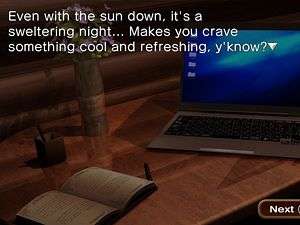 Sadly, it’s wholly superfluous to the game and perhaps a little too saccharine for western audiences, especially when (without spoiling anything for those who choose to follow the storyline) the foundation of the narrative is that his father wanted to be the best example to him that he possibly could, to the point where something serious happened and, rather than staying with family, he went fishing to prove to his boy that he was a worthy father by keeping a promise to him. In Japanese culture that may be perfectly acceptable but, to be brutally honest, it just seemed utterly ridiculous that anyone would go fishing rather than stand by the family he loved so much, just because he’d promised his boy that he’d catch a fish for him.
Sadly, it’s wholly superfluous to the game and perhaps a little too saccharine for western audiences, especially when (without spoiling anything for those who choose to follow the storyline) the foundation of the narrative is that his father wanted to be the best example to him that he possibly could, to the point where something serious happened and, rather than staying with family, he went fishing to prove to his boy that he was a worthy father by keeping a promise to him. In Japanese culture that may be perfectly acceptable but, to be brutally honest, it just seemed utterly ridiculous that anyone would go fishing rather than stand by the family he loved so much, just because he’d promised his boy that he’d catch a fish for him.
Bizarre narrative aside, however, the underlying fishing game itself – and I say ‘underlying’ because the story is tightly woven throughout and plays out at the start and end of every challenge – is by far the best I’ve played in terms of variation and choice. There’s no freeplay mode until you complete the storyline, so for each of the fifty-two weeks of the year, you are tasked with catching a certain number of one species, based on your father’s journal. In that respect, it’s quite linear, but there’s always many more varieties in each respective area rather than just those you are required to hook, and each catch will provide reward points regardless of whether they’re part of the objective or not.
 |
 |
 |
 |
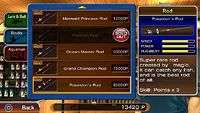 |
 |
A perfect example of this would be in one of the later challenges where the target species is the bluefin tuna, but the waters are also teeming with mahi mahi, giant sea bass, and the odd straggler here and there. Despite the challenge being to pull in several bluefin tuna – each of which had to be over 250cm in length – it was actually very difficult to hook any as the other fish were getting to the bait before the tuna. Sure, there are ways to get the unwanted fish to lose interest by simply not responding to their bite, but when you’re playing with a rod that has a triple points bonus and you’re trying to build up enough to buy the ‘super rare’ Poseidon’s Rod, you’re going to keep reeling all those unwanted suckers in.
 Each challenge carries a set number of points for achieving the objective, and if your catch is even one millimetre shy of the specified size, it’s back to the waterside for you. As you’d expect, each type of fish has its own food preference, and this is where the bait and tackle shop comes into play. Run by a grey-haired and goatee-sporting Eric Roberts lookalike, this is where you buy rod upgrades, live bait, lures, and even ornaments for your own basement aquarium display. By ‘locking on’ to a specific fish, you’ll immediately have the best bait highlighted so you don’t end up trying to catch a shark with a worm (there are no sharks, sorry), and you can buy as many or as few as you like. The rods unlock as you progress through the storyline and vary in price from a few thousand points up to a whopping 95,000, with each sporting its own strengths and weaknesses.
Each challenge carries a set number of points for achieving the objective, and if your catch is even one millimetre shy of the specified size, it’s back to the waterside for you. As you’d expect, each type of fish has its own food preference, and this is where the bait and tackle shop comes into play. Run by a grey-haired and goatee-sporting Eric Roberts lookalike, this is where you buy rod upgrades, live bait, lures, and even ornaments for your own basement aquarium display. By ‘locking on’ to a specific fish, you’ll immediately have the best bait highlighted so you don’t end up trying to catch a shark with a worm (there are no sharks, sorry), and you can buy as many or as few as you like. The rods unlock as you progress through the storyline and vary in price from a few thousand points up to a whopping 95,000, with each sporting its own strengths and weaknesses.
Deciding which to buy can be a struggle at times, as one rod may have high speed, high power, but a low durability so you may be able to land much larger fish with it, but keeping them on the line will be a challenge as it will have a tendency to break and you’ll lose your bait and have to start again. Having said that, going with a high-durability rod that only has a low speed and medium power will mean that you’ll undoubtedly hold on to the fish with a lessened risk of snapping the line, but it could take you ten times longer to actually land it due to the speed of the reel and the pulling power of the rod itself. The problem is that you never know what the next challenge will bring, so it’s generally best to go with a rod which has equal coverage of all aspects and learn to deal with its inadequacies by adapting your technique.
As well as being a vendor, the tackle store owner was once a friend of your father’s and so his recollections of years gone by will invariably result in a number of quests where you’ll be asked to fulfil a specific remit over no particular length of time. The first is the Beginner’s Guide to Lake Fishing, where you have to bring back five small Asian crucian carps and five small bluegills. This was achieved relatively easy as an aside to the main challenges, as you’re bound to catch various species along the way, but by the time I’d completed the full storyline I still hadn’t caught a single qualifying bass for the second quest so I have no idea what the rest of the quests are. For the completionists among us who want to continue gameplay after the storyline has finished, however, the side quests add a welcomed longevity.
 As with many Vita games, there’s a choice of whether you use the touch screen or the dedicated controls. Casting the line can be done by either touching the highlighted area of the rod on-screen, or holding the circle button, and moving the lure through the water can be achieved by shifting the left analogue stick or swiping the left and right areas of the screen. Reeling in and landing is where it gets slightly more complicated – when a fish takes the bait you have to immediately swipe upwards on the screen and start to tire your catch out by pulling against its intended direction.
As with many Vita games, there’s a choice of whether you use the touch screen or the dedicated controls. Casting the line can be done by either touching the highlighted area of the rod on-screen, or holding the circle button, and moving the lure through the water can be achieved by shifting the left analogue stick or swiping the left and right areas of the screen. Reeling in and landing is where it gets slightly more complicated – when a fish takes the bait you have to immediately swipe upwards on the screen and start to tire your catch out by pulling against its intended direction.
Initially, I was doing this by swiping the screen when prompted, but it would often interfere with my cautious approach to reeling (making circles on the screen) so I switched to the easier method of using the left stick to pull the rod in a specific direction while I maintained the reeling movement with my right hand on the touch-screen. My only issue with the controls is that there wasn’t enough of an explanation as to what everything does, so there’s a considerable amount of trial and error involved in the earlier stages.
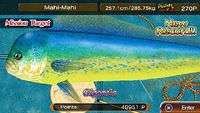 |
 |
 |
 |
 |
 |
Smaller fish will tire quickly and land easily, while the larger beasts can easily take four or five minutes of careful manipulation to get them to the point where they break the surface. One particularly tough catch was the huchen, which would almost always break my line when I thought I was finally getting somewhere with it, and as it was a timed challenge it meant that I was repeatedly failing. Switching rods between casts made a difference, however, and the high-durability rod meant that I was able to finally pull the three gigantic huchen in, but the time required to do so was much longer as the speed and power were severely compromised in favour of the stronger line, so when I finally passed it was with mere seconds to go. As someone who spent many of my childhood years switching between bank and sea fishing, it’s a very accurate representation of what’s actually required in these scenarios and Natsume should be commended for opting to veer away from the spoon-fed approach of ‘any rod and line will do’ that other games have shown in the past.
After you complete the year’s worth of challenges, freemode opens up where you can visit any of the completed tasks and replay them at your leisure. You don’t lose any points in doing so, which means you’re able to work towards the ridiculously expensive Poseidon’s Rod and finish all of Eric Roberts’ quests, as well as populate your aquarium with the finest specimens from your fishing adventures. It may be a little pricey for a mere fishing game, coming in at £19.99, but it’s certainly enjoyable and challenging enough to justify the outlay if you want to while away the hours and not have to engage your brain too much or do anything too difficult. In fact, I’d go as far as to say that it’s the best fishing game I’ve played across all handheld devices.
Pros- They've gone for a more realistic aesthetic with the fish, which is great
- Fifty-two challenges across all four seasons offers a strong variety of catches
- Choice of baits, lures, and rods is extensive and varied
- Plenty of reasons to come back and improve on previous scores
- Controls are easy to master very early on, albeit not explained in enough detail
- Storyline is superfluous and, at times, completely unrealistic
- Would have been good to experience some big-game fishing
- An option to keep a certain rod but upgrade the reel/line would have been good
Reel Fishing: Master's Challenge suffers a little from a cultural desire to shoehorn familial morals into what would otherwise be an extremely solid fishing game. Granted, each line of the monologue can be skipped by pressing 'X' - or the entire scene skipped using the 'select' key - but it's still a little jarring to always come back from fishing and discover another bizarre anecdote from his father's journal. As a fishing game, however, it stands up well against its few competitors and offers a varied enough journey through a full year with a great choice of baits, lures, and equipment. With something in the region of eight hours worth of gameplay for a single playthrough of the storyline, and an unlimited freemode thereafter, it's a great option for those of us who once enjoyed fishing, or who long for a little escapism outside of fetch quests and gunfire.
Last five articles by Mark R
- From Acorns to Fish
- Alone In The Dark
- Why Borderlands is Better Than Borderlands 2
- Falling Short
- The Division: A Guide to Surviving the Dark Zone Solo


















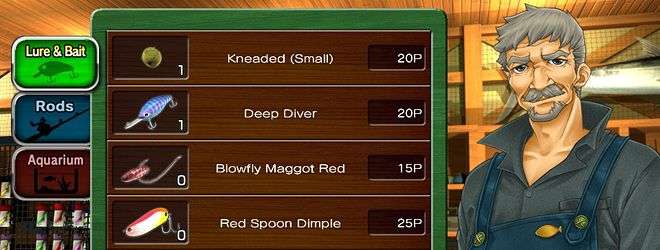
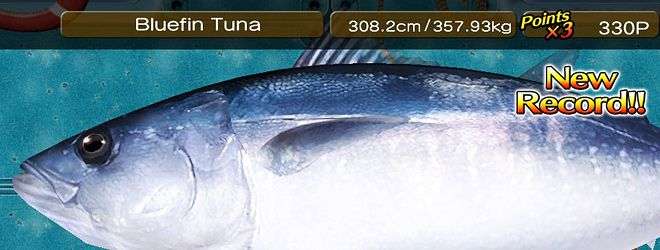






There are no comments, yet.
Why don’t you be the first? Come on, you know you want to!